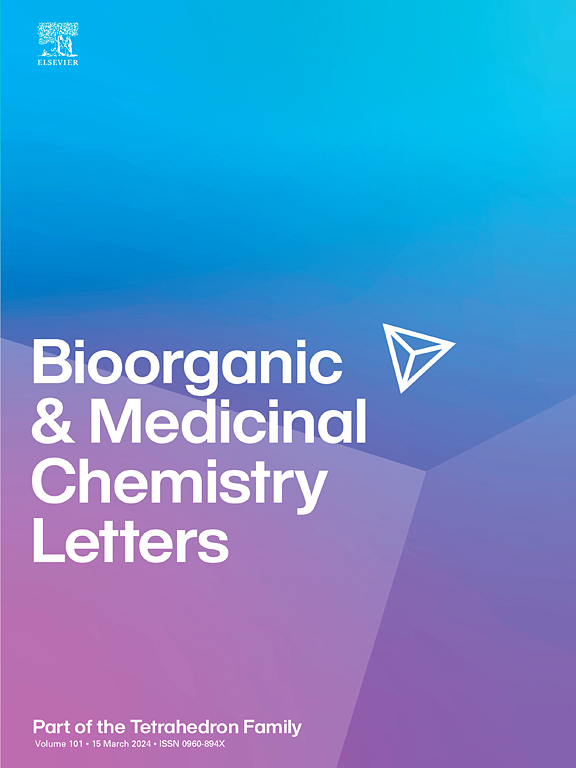具有两种不同硫连接物的两类双基化合物的抗疟生物学评价
IF 2.5
4区 医学
Q3 CHEMISTRY, MEDICINAL
引用次数: 0
摘要
恶性疟原虫激酶已被广泛研究,因为它们有潜力作为发现替代青蒿素联合疗法的靶点。它们在寄生虫血期复制中的作用及其与人类激酶的同源性已经导致已经测试的抗肿瘤激酶抑制剂作为抗疟原虫药物的开发。恶性疟原虫胆碱激酶(PfCK)是一种参与磷脂合成的胞质酶,是疟原虫耐药菌株的一个有希望的靶点。PfCK利用宿主胆碱并催化其转化为磷酸胆碱,这是红细胞内新寄生虫后代所需的脂质膜形成的关键步骤。之前,我们描述了人类胆碱激酶(hCK)抑制剂的两个文库(PL和FP)的合成,我们按照绿色设计方法生成。其中一些化合物被发现具有抗肿瘤的特性。在这里,我们评估了相同的化合物作为PfCK和抗疟药的潜在抑制剂。有趣的是,虽然FP文库中含有二硫化物连接体的化合物在nM范围内表现出与阳离子头无关的PfCK抑制作用(FP3是最活跃的化合物,PfCK IC50 = 0.16 μM),但它们对感染红细胞没有影响。另一方面,具有二硫乙烷连接的PL文库化合物显示出对寄生虫的体外活性,但对分离的酶没有抑制活性(PL40显示出最高的抗疟活性,IC50 = 10 nM)。这种相关性的缺乏可能是由于细胞在体外的二硫化物降解或二乙烷库的替代靶标的存在。考虑到先前报道的PL家族的抗癌潜力和本文报道的抗寄生虫活性,这些化合物可能被认为是开发多功能药物的良好起点。本文章由计算机程序翻译,如有差异,请以英文原文为准。

Biological evaluation as antimalarial of two families of biscationic compounds featuring two different sulphur linkers
Plasmodium falciparum kinases have been widely studied due to their potential as targets for the discovery of alternatives to artemisinin-combined therapies. Their role in parasite blood-stage replication and their homology with human kinases has led to the exploitation of already tested antitumoral kinase inhibitors as antiplasmodial drugs. Plasmodium falciparum choline kinase (PfCK), a cytosolic enzyme involved in phospholipid synthesis, is a promising target for parasite resistant strains. PfCK uses the host choline and catalyzes its transformation in phosphocholine, a key step for the formation of the lipid membranes required by the new parasite progeny inside the erythrocyte. Previously, we described the synthesis of two libraries (PL and FP) of human choline kinase (hCK) inhibitors, which we generated following a green by design approach. Some of these compounds were found to exhibit antitumoral properties. Here, we evaluated the same compounds as potential inhibitors of PfCK and antimalarial agents. Interestingly, while the compounds of the FP library, which feature a disulphide linker, show PfCK inhibition in the nM range independently of the cationic head (FP3 being the most active compound, PfCK IC50 = 0.16 μM), they show no effect on infected erythrocytes. On the other hand, the compounds of the PL library, which feature a dithioethane linker, show in vitro activity against the parasite but no inhibitory activity against the isolated enzyme (PL40 exhibits the highest antimalarial activity, with IC50 = 10 nM). This lack of correlation could be due to either cellular disulphide degradation in vitro or to the existence of alternative targets for the dithioethane library. Considering the previously reported anticancer potential of the PL family and the antiparasitic activity reported herein, these compounds may be considered as good starting points for the development of multifunctional drugs.
求助全文
通过发布文献求助,成功后即可免费获取论文全文。
去求助
来源期刊
CiteScore
5.70
自引率
3.70%
发文量
463
审稿时长
27 days
期刊介绍:
Bioorganic & Medicinal Chemistry Letters presents preliminary experimental or theoretical research results of outstanding significance and timeliness on all aspects of science at the interface of chemistry and biology and on major advances in drug design and development. The journal publishes articles in the form of communications reporting experimental or theoretical results of special interest, and strives to provide maximum dissemination to a large, international audience.

 求助内容:
求助内容: 应助结果提醒方式:
应助结果提醒方式:


